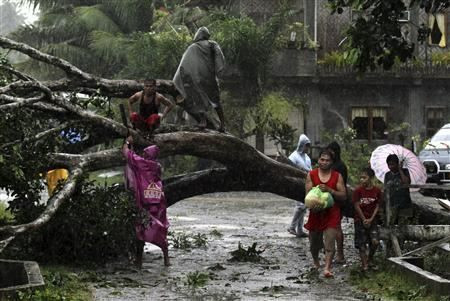Typhoon Bopha Slams South Philippines, 40 People Dead Or Missing

Typhoon Bopha, a powerful weather system that officials have warned for days could be “catastrophic,” made landfall on the Philippine island of Mindanao early on Tuesday morning, leaving 40 people dead or missing.
Dozens more were left injured by falling trees or other debris and Liza Mazo, Chairperson at Davao Regional Disaster Coordinating Council, warned that the death toll would likely rise, reported Reuters.
The typhoon, which is known locally as “Pablo,” made landfall just before 4:45 a.m. (3:45 p.m. Monday ET), according to a report from the National Disaster Risk Reduction and Management Center. It generated wind gusts as high as 195 kph (121 mph) and was reclassified as a “super typhoon” at one point on Monday, but apparently slowed down slightly after striking Mindanao, according to the Philippine Atmospheric Geophysical and Astronomical Services Administration.
Before the typhoon struck the island, the agency warned of possible landslides and flash floods, urging seven provinces on Mindanao to make necessary preparations. Heeding the warnings, more than 155,000 people relocated to shelters by Tuesday, a measure that likely reduced the death toll. Government agencies also issued warnings to military and hospitals to be on standby, suspending school classes in some Philippine cities, and moving emergency supplies into readily accessible places. About 80 flights were cancelled along with ferry services in the south and central regions of the Philippines.
But in spite of the precautions authorities said that millions of people, many residents of remote communities, were located in the storm’s path. The typhoon also came on the heels of a series of devastating storms that have left the country battered. Bopha came within mere weeks of the one-year anniversary of Washi, a typhoon that struck Mindanao in late 2011, killing 1,249 people and destroying entire villages. Four months ago in the capital of Manila, about 1,000 km north of Mindanao, 80 people were killed by flooding.
Derek Williams, a meteorologist for the U.S. National Weather Service in Guam, added that the small island country of Palau, which has a population of roughly 20,609, narrowly escaped being struck by Bopha.
"It was headed right toward Palau," said Williams. But in the final moments, Bopha "just turned to the west and fortunately went south of them.”
"I really think they escaped the brunt of the storm," Williams added. "The fast movement of the system really prevented a lot of flooding. I think probably only a few inches of rain fell, so that's certainly good news, because Palau itself is susceptible to mudslides."
© Copyright IBTimes 2025. All rights reserved.





















